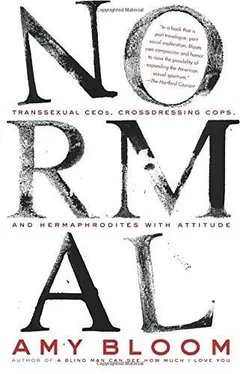And he’s in New York, it happens, attending the symposium. The first thing on Dr. Pfafflin’s mind when I meet with him and Peggy Cohen-Kettenis, a Dutch clinical psychologist who knows him well and has suggested a joint interview, is where he can smoke.
“It’s amazing,” he says. “In America I don’t feel like a smoker, I feel like a murderer.”
I assure him that I don’t mind smoking, and we go to my hotel room, but he doesn’t smoke there either, because there are no ashtrays.
Dr. Pfafflin absolutely knows where he gets his numbers. He doesn’t seem to think much of American record-keeping, but he has found the data banks in Germany, the Netherlands, Australia, and Sweden to be reliable, and has been doing research and follow-up studies for the last twenty years. He shows me two studies. The first is based on the Bem Sex Role Inventory, a psychological test, oriented differently for men and women, to assess feelings of masculinity and femininity; one of its underlying assumptions is that a mix of masculine and feminine is normal and healthy in both males and females. The study compares female-to-male (FTM) transsexuals, before and after hormonal and/or surgical treatment, with “normal”—that is, genetic — females. The transsexuals test out as high masculine/low feminine before the treatment, and afterward as well-adjusted men who accept their feminine side.
The second study, based on a German psychological test similar to the Minnesota Multiphasic Personality Inventory (a psychological personality evaluation widely used in the gender dysphoria clinics here), has even broader implications. The FTM transsexuals are compared with normal men and with normal women, and I don’t need to read German to understand the charts: they are as clear as cartoons. The good-sized gray bar down the middle is normal men on page one, normal women on page two; green lines that run in and out of the gray bars are the untreated transsexuals, and red lines that run square in the center of the male page and close to the middle on the female page are the post-op transsexuals. “They are completely in the normal range, psychologically, for men, after treatment,” Pfafflin says, running his finger up and down the gray bar. “Even before treatment, they are not so off the norm for women” (which suggests, unpleasantly, that the norm for women contains a fair amount of depression and low self-esteem). Pfafflin also mentions other clinical and research studies showing no unusual levels of psychopathology in the families of transsexual teenagers or in the adolescents themselves.
Neither Pfafflin nor Cohen-Kettenis appears to be particularly impressed by the surgeons in their field. Cohen-Kettenis, consistently more tactful, shrugs slightly when I ask about the exchange of ideas between the surgeons and the mental health people here at the conference. Pfafflin laughs. “Well, they are naïve, like children. They love to build. I will build a little clitoris, I will build a little penis.”
Cohen-Kettenis smiles. “Not a little penis. Only big ones.”
Although they attend the surgeons’ presentations (ten to twenty minutes of endless, blurring slides of penises and vaginas and recontoured chests and abdominal flaps and forearm donor sites and Y-shaped incisions), they don’t expect the surgeons to attend the psychological presentations. Laub has told me that the surgeons do. He does.
Cohen-Kettenis says, “We need to know about the surgery for our patients, to provide information. The surgeons don’t need to know what we do, or think.”
“And they wouldn’t understand,” Pfafflin says, and then corrects himself, perhaps remembering that his colleagues might read this. “Some of them wouldn’t. Anyway, they have their psychologists and so on screening the patients for them, so they don’t need to know.”
When I find Don Laub again, in a meeting room filled with energetic, well-dressed men and women whose genetic origins are impossible to know, I ask him about the root of high-intensity transsexuality, the kind for which surgery seems to be the only solution. “I believe it’s biological and behavioral,” he says. “A behavioral problem with a surgical solution. There have been a number of experiments, corroborated over and over, at Wisconsin, at Oregon, at Stanford. They injected lab mammals — cats, rats, dogs, and monkeys — with opposite-sex hormones shortly before birth. And that was it. No matter what kind of conditioning you used on those mammals, they behaved consistently like the opposite sex, like the gender of the hormone with which they were injected. And I think that that’s what we’ll find, eventually: a biological answer.
“Of course, we’re the true believers here. We know we’re right. I’ve been doing Interplast for years now, and it’s taken off, people understand, they give money to it. But with this, with gender dysphoria, people still don’t get it, they don’t accept it. For twenty-five years I’ve been doing this work, and the only people who really understand it are all at this meeting. Or they’re the patients. When plastic surgeons begin doing this work, a lot of them just see the technical challenge, the professional opportunity. They dislike the whole idea of transsexuals, but they’re fascinated by the challenge. But when they meet the patients, they change — they become more empathetic. They see the people and they are forever changed.
“You know, this is the ultimate body-image surgery. And if people are fundamentally at peace with themselves, like any other cosmetic surgery, they’re likely to have a good outcome. I’ve learned from my gender patients: I screen my cosmetic patients better now. A forty-five-year-old woman with small breasts, whose real agenda is to have breast augmentation because her husband works for an international corporation and when he’s on the road he takes out every big-busted lady he can find — she’s not a good candidate. After she’s happy, after she’s worked out her marriage, then she’s a good candidate, if that’s what she wants. These gender patients, they cross-live, they have therapy, they’re evaluated over and over. By the time they have the surgery, they’re successful economically, socially, psychologically, usually sexually too. Those are good candidates for plastic surgery. And that’s how the other patients should be too, but we don’t usually do that kind of screening, we don’t expect it of the patient or of the surgeon.”
I ask Laub what developments he anticipates in his field.
“The future has three parts,” he says. “FTM surgery’s going to improve, aesthetically and in other ways. I learned something here at the conference. I’m going to start doing it right away. They showed how to construct the glans, how to build up a corona. I’ll start doing that. And they tattoo a pinkish color onto the head — that helps too. I’m going to do that. And in the future there might be transplants, if we can figure out how to reduce rejection. I don’t think the government will fund penis transplants, but we’ll try to persuade it to. And there’s the chemical approach, trying to prevent problems, handling tissue receptors differently, correcting. And then we come back to surgery, and we keep trying to make it better. Because that’s what the patients need, and that’s what we strive for: the best anatomical solution to the problem, since the problem has no other solution.”
Until fairly recently, pragmatic, solution-oriented approaches like Don Laub’s were anathema to clinical theorists, whose diagnoses and suggestions for treatment focused primarily on male-to-female transsexuals and on the inevitable opinions about preexisting family pathology. Absent fathers, overinvolved mothers — that was the traditional psychoanalytic explanation for male homosexuality, and for transsexuality as well, though some clinicians have taken the opposite view: dominant fathers, submissive mothers. The other two major psychological theories are that parents of transsexuals encourage cross-gender identification and play, and that parents of transsexuals strongly discourage cross-gender identification and play. That about covers it. I can’t imagine that with the dominant and absent fathers, the passive and active mothers, and the encouraging and discouraging of cross-gender behaviors, we’ve left out too many American families (except the single parents, and they have their own problems). According to these theories, there should be millions of transsexuals in America alone, and McSurgery centers in every good-sized town.
Читать дальше












